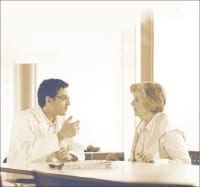Advances in Molecular Genetics Offer Hope to Cancer Patients
SPRINGFIELD — Lung cancer, especially in its advanced stages, is still very difficult to treat. The good news is that advances in molecular genetics are resulting in new ‘designer therapies’ which offer greater hope for lung-cancer patients who are told they have an incurable disease.
“The advances in combating lung cancer that we are seeing now are a direct result of the Human Genome Project,” said Dr. Christopher Otis, director of Surgical Pathology at Baystate Medical Center. “The key to the future is going to be these personalized, directed therapies, where we look at a patient’s tumor — the words I use among colleagues are ‘interrogating’ or ‘investigating’ tissue taken during biopsy to identify already-known gene mutations that alter the basic backbone of cellular life.”
It is precisely these molecular mutations which are the target of the new designer therapies offering some patients a chance at a longer life expectancy after diagnosis. Pathologists in the laboratory, looking at tissue taken by radiologists during a core biopsy, are key to identifying specific cell types and any molecular or genetic changes in them that will help oncologists make important decisions regarding the most effective treatment for their patients. It’s what some doctors are now referring to as ‘personalized medicine.’
The three common gene mutations that have been identified in lung cancers so far are EGFR, KRAS, and ALK. “We have custom-designed, molecular therapies for two of these mutations that target the altered proteins that come off this altered DNA, effectively shutting them down for a time and stopping the cancer cells from multiplying,” said Otis.
While promising for those who have mutations in the EGFR and ALK genes — there is no drug yet designed for KRAS — only a small fraction of patients with lung cancer have these mutations that can be effectively targeted with new therapies. However, the Baystate pathologist said he expects treatment for simply the three main mutations to expand by a much greater magnitude over the years.
“The way I see this happening is that those three main mutations we have identified will expand slowly to 12, then over the course of time will expand again to 100, then 1,000 and even 10,000 and more in the future. Along with that expansion will come an increase in therapies to benefit our patients. Some will be drugs that are already approved for use in other cancers, while other new designer therapies, some already in experimental use now, will have to be developed,” Otis said.
“Our next challenge will be to learn why the cells we are attacking eventually develop a resistance to these new designer drugs and how we can counteract that process,” he added.



Comments are closed.